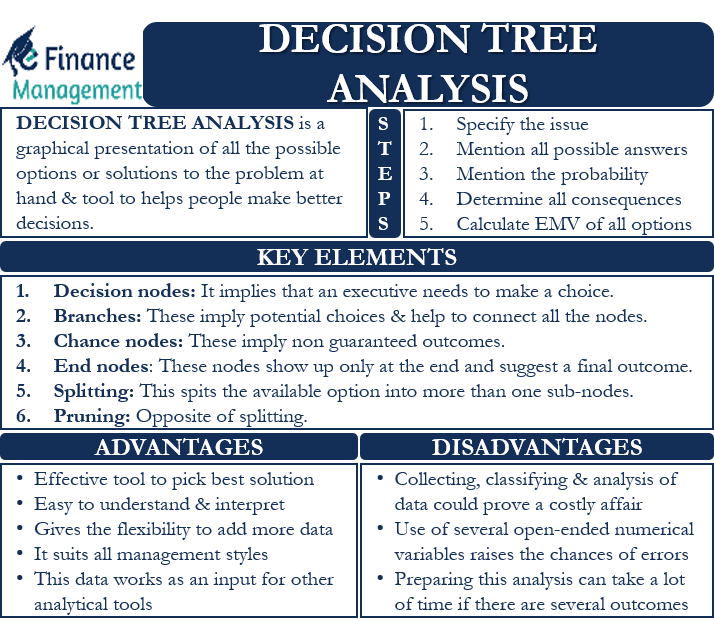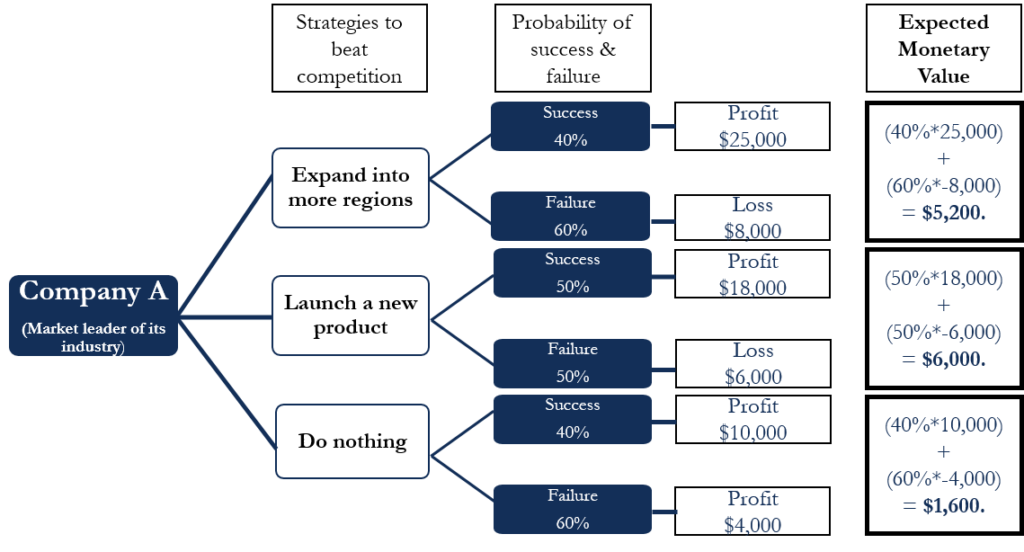A Decision Tree is a graphical chart and tool to help people make better decisions. It is a risk analysis method. Basically, it is a graphical presentation of all the possible options or solutions (alternative solutions and possible choices) to the problem at hand. The name decision tree comes from the fact that the final form of any decision tree must resemble a tree with roots and leaves. In place of roots and leaves in a real tree, a decision tree has options and solutions. For any executive, it is very important to know decision tree analysis, including how to use it, its pros and cons, and related terminologies.
Key Elements of Decision Tree Analysis
To understand decision tree analysis, it is crucial that you know all its key elements. These are:
Decision Nodes
A decision node in a decision tree implies that an executive needs to make a choice. Basically, the node is the point where a choice and options are given. Or the node is a single point from where the process flow branches out in two or more different directions. Each branch or direction offers a different possible outcome. As you choose the option on the likely outcome and steps are there on that path.
Branches
In a decision tree, branches imply potential choices. Also, the branches help to connect all the nodes.
Chance Nodes
Such nodes in a decision tree imply non-guaranteed outcomes.
End Nodes
As the word suggests, these nodes show up only at the end and suggest a final outcome.
Splitting
This spits the available option into more than one sub-nodes.
Pruning
It is the opposite of splitting. Pruning takes place when the decision tree maker is able to eliminate one or more sub-nodes from a decision node.

Steps in Decision Tree Analysis
A decision tree analysis may sound like a complex management tool, but it is comparatively easier to make. Following are the steps or processes to make or perform a decision tree analysis:
Also Read: Risk Analysis Methods – Meaning and Types
- We first need to understand and specify the issue for which we need a decision tree.
- Next, we need to think of and detail all the possible answers to the issue.
- Now, we need to put the possible solutions and their probability values on a decision tree.
- Next, determine all the consequences of the possible solutions, and mark those on the decision tree.
- In the last step, we need to calculate the EMV (Expected Monetary Value) values of all the options (chance nodes). This would give us the solution where one will go with the highest expected value.
Example of Decision Tree Analysis
Let us take a simple example to understand the decision tree analysis.
Company A is a market leader in its industry, but the competition is rising now. So now the management needs to take a call and come up with the right strategy to handle or beat the upcoming competition. It has three options.
- The first is to expand into more regions.
- The second is to launch a new product.
- And the third is to do nothing and wait for rivals to make a mistake.
After thorough research and discussions, the management has come up with the possible outcomes and the probabilities of the success of each strategy.
I. For the first option (expand into more regions), management estimates that there is a 40% chance that this strategy will help to raise the market share. This may give a profit of $25,000.
Also, management estimates that there is a 60% chance that this strategy may not work. And rivals may take over the market share. This may give a loss of $8,000.
II. For the second option (launch a new product), the management estimates a 50% chance for the success of the new product. This would raise the profit by $18,000. This strategy also has a 50% failure rate, resulting in a loss of $6,000.
Also Read: Strategic Options
III. The third option of doing nothing also has two outcomes. Management estimates that it has a 40% chance to up its market share and post a gain of $10,000. Also, there is a 60% chance that if Company A does nothing, it will lose to rivals, leading to a loss of $4,000.
For a decision tree analysis, we need to mark all the three strategies, as well as their outcomes, on the decision tree. Next, we need to calculate the EMV of each strategy.
I. EMV for the first strategy (expand into more regions) = (40% * $25,000) + (60% * -$8,000) = $5,200.
II. EMV for the second strategy (launch a new product) = (50% * $18,000) + (50% * – $6,000) = $6,000.
III. EMV for the third strategy (doing nothing) = (40% * $10,000) + (60% * -$4,000) = $1,600.
From the above decision tree analysis, it is clear that the second option (launch a new product) has the highest EMV. Such a strategy is more likely to result in maximum profit.

Advantages and Disadvantages of Decision Tree Analysis
The advantages of decision tree analysis are:
- This analysis gives the best available answer to the issue at hand. Or, we can say it is an effective tool for picking the best solution after considering all the available options.
- The Decision Tree structure makes it quite easy to understand and interpret the depth of the problem and likely solutions with outcomes. Moreover, classifying data into different classes is easy as well.
- The data from the decision tree works as an input for other analytical tools, such as nature’s tree.
- A key advantage of this analysis is that this analysis combines the impact and effect of qualitative as well as quantitative data and variables. Therefore, the outcome and likely solution seem to be the best on an overall assessment basis.
- The graphical representation of the options makes it very clear and easy to understand the full analysis.
- This analysis gives the flexibility to add more data as well. For instance, in the above example, if there are four options instead of three, then one can easily add this option to the decision tree.
- The decision tree analysis suits all management styles, such as waterfall project management, agile, kanban, etc.
Following are the disadvantages of decision tree analysis:
- Such a tool may not be useful if there are several data classifications. The more variables and options are there. It becomes difficult to put them into the structure and difficult to understand.
- If there are several outcomes and options, then preparing this analysis could become a time-consuming and tiring affair. Moreover, it gets complex to understand as well.
- If the decision tree maker does not have much experience, then they may make a mistake in classifying variables into different classes.
- In case one needs to make any change or rectify any error, then it could lead to a wastage of time. Moreover, the rectification may also completely change the decision tree structure and the decision.
- The use of several open-ended numerical variables raises the chances of errors.
- This analysis may get biased if the decision tree maker gives more preference to some variables.
- Collecting, classifying, and then analysis of data could prove a costly affair. We need a person with a specific skill set to prepare and interpret this.
Final Words
Decision tree analysis is an effective tool to evaluate all the outcomes in order to make the smartest choice. They are easy to create and understand as long as it does not involve too many variables. So, if we believe our decision tree would involve too many options and outcomes, then it is better not to go for this tool.

